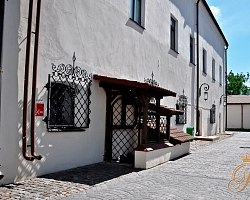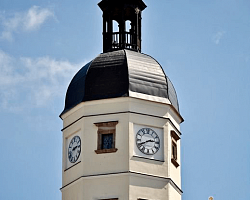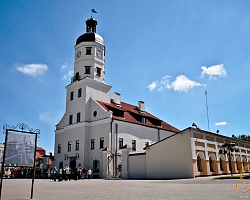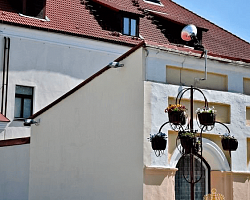Niasvizh Town hall
Magdeburg Rights is known from the XIII century. Firstly it acted in Magdeburg, then spread to cities of Eastern Germany, Central and Eastern Europe. It acquired a characteristic features that featured it from the city rights of Magdeburg in Great Duchy of Lithuania.
Niasvizh Town Hall — a memorial of architecture of the 16th century — is the most ancient among the town hall buildings preserved in the territory of Belarus. Its construction began, in the judgment of quite a number of researches, under the design of the Italian architect Giovanni Maria Bernardoni after the town had acquiered the Magdeburg Right. Stefan Batory, King of Rzecz Pospolita and Great Prince of Lithuania signed the Privilege on Magdeburg Right for Niasvizh in Grodna on April 23, 1586. It permitted the town to enjoy full rights ofself-government, tax remissions,jurisdictional immunity, profitable conditions for the craftsmen and tradespeople. At the same time, Niasvizh received its emblem.
The second Privilege of June 18, the same year, was granted to the town by the owner of Niasvizh Mikołaj Krzysztof «the Orphan» Radziwiłł. In accordance with the latter Privilege, the municipal authority had to construct a «stone town hall». Ten years after Magdeburg Right had been conferred, the Town Hall was erected in 1596. The first graphic representation of Niasvizh Town Hall came to us in Tomasz Makowski’s engraving (about 1604). The ancient etching depicted the town clock, bells, and observing platform on the tower. The town council building erected on the citizens’ money was the main place for every township member to solve his urgent problems for several centuries.
The edifice is simple in shape but massive in volume. The mall consisting of numerous cell-likeshops was constructed in the same style. There were 52 stone-walled shops in the 17th century. Thedriveways between them and the Town Hall building were closed with solid gates. In the so-called «Magdeburg period» (the end of the 16th century-1836), the Town Hall basement housed a prison; the ground floor contained the mall, municipal weigh station, watch room, arms storefor the citizens in case of jeopardy, special premises for storage of fire extinguishing equipment. The first floor was given to the municipal councilinstitutions. Those were the Council Hall, Courtroom, Conference Hall, Archive, Skarbnica (depository), and Vojt’s and Starostas’ offices. The municipal archive with administration books and Privileges granted to the town by the Kings and Radziwiłłs was kept there as well.
During the Northern war, the Town Hall wason fire, it was restored in 1752. The great fire of 1836 caused an irreparable damage to the edifice, the first-floor rooms suffered very badly. The tower reduced from six to four levels. It was since that time till the end of the 19th century, that the Town Hall stayed at loose ends. The repair work was carried on at a different rate almost till the decline of the Russian Empire. From the end of the 19th century to 1939, the Town Hall and Municipal Council, Powiat Starosta’s office, police and town administration were located there. After the Great Patriotic War, the Town Hall housed the district Palace of Culture, later the Palace of pioneers and schoolchildren, children’s library.
From 1997 to 2004, the repair work was carried out at the Town Hall, memorial of architecture of the 16th-18th centuries. It resulted in an initial appearance of the facades, renewal of the tower upper floors. The tower regained a municipal clock (like the one in the 16th century) and observing platform. The interiors of the first floor were reconstructed for the museum exposition «Municipal self-government of Niasvizh in the 18th- the first half of 19th centuries».









